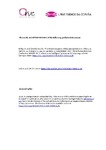Robobo: The Next Generation of Educational Robot

Use este enlace para citar
http://hdl.handle.net/2183/39348Colecciones
- Investigación (EPEF) [593]
Metadatos
Mostrar el registro completo del ítemTítulo
Robobo: The Next Generation of Educational RobotAutor(es)
Fecha
2018Cita bibliográfica
Bellas, F. et al. (2018). Robobo: The Next Generation of Educational Robot. In: Ollero, A., Sanfeliu, A., Montano, L., Lau, N., Cardeira, C. (eds) ROBOT 2017: Third Iberian Robotics Conference. ROBOT 2017. Advances in Intelligent Systems and Computing, vol 694. Springer, Cham. https://doi.org/10.1007/978-3-319-70836-2_30
Resumen
[Abstract]: This paper presents Robobo in the context of higher education. Robobo is a low-cost educational mobile robot that combines a simple wheeled base with a smartphone, which provides the latest technology to the robot. With Robobo, students can develop their own projects through ROS using cameras, microphones or high-resolution screens, bringing teaching closer to the real requirements of the market they will find when they finish their studies. In this work, the hardware and software development that has been carried out is described in detail. Furthermore, it is presented an exemplifying case of student project that shows the potentiality of Robobo in this context.
Palabras clave
Educational robots
ROS
Human-robot interaction
ROS
Human-robot interaction
Descripción
This version of the conference paper has been accepted for publication, after peer review and is subject to Springer Nature’s AM terms of use (https://www.springernature.com/gp/open-science/policies/accepted-manuscript-terms), but is not the Version of Record and does not reflect post-acceptance improvements, or any corrections. The Version of Record is available online at: https://doi.org/10.1007/978-3-319-70836-2_30. Included in: Proceedings of the ROBOT'2017: Third Iberian Robotics Conference which took take place in Sevilla, Spain November 22-24, 2017.
Versión del editor
Derechos
©2018 Springer International Publishing AG. Subject to Springer Nature’s AM terms of use (https://www.springernature.com/gp/open-science/policies/accepted-manuscript-terms).
ISSN
2194-5357
ISBN
978-3-319-70835-5





